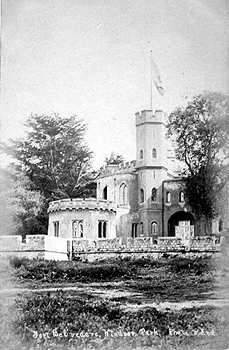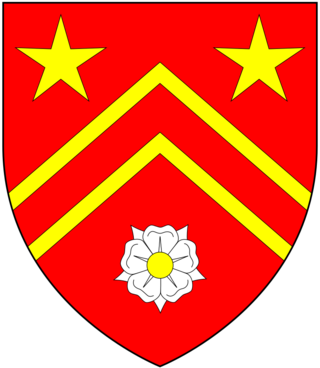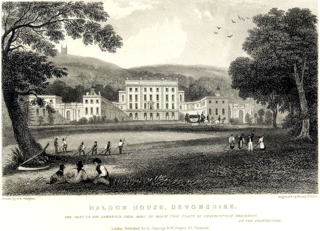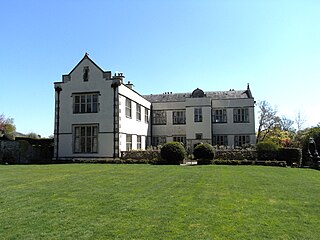
Major-General Stringer Lawrence was a British military officer who served as the first Commander-in-Chief of Fort William from 1748 to 1754.

Fort Belvedere is a Grade II* listed country house on Shrubs Hill in Windsor Great Park, in Surrey, England. The fort was predominantly constructed by Jeffry Wyatville in a Gothic Revival style in the 1820s.

Sir Robert Palk, 1st Baronet of Haldon House in the parish of Kenn, in Devon, England, was an officer of the British East India Company who served as Governor of the Madras Presidency. In England he served as MP for Ashburton in 1767 and between 1774 and 1787 and for Wareham, between 1768 and 1774.

Aaron Eli Baker (1610–1683) of Bowhay in the parish of Exminster, near Exeter, Devon, was an English colonial agent of the Honourable East India Company, who served as the first President of the Madras Presidency (1652-1655). He was for the duration of twenty years President of Bantam in the East Indies. He made a fortune in the East India trade.

The Haldon Hills, usually known simply as Haldon, is a ridge of high ground in Devon, England. It is situated between the River Exe and the River Teign and runs northwards from Teignmouth, on the coast, for about 24 km (15 mi) until it dwindles away north west of Exeter at the River Yeo, just south of Crediton. The highest points of just over 250 metres (820 ft) lie to the south west of Exeter. The southernmost part is known as Little Haldon; it is partially separated from the main bulk of the hills by a col formed by the valleys of the Dawlish Water to the east and the valley at Rixdale to the west.

Dunchideock is a small civil parish on the north eastern slopes of the Haldon Hills in Teignbridge, Devon, England. It covers an area of 392 hectares and lies about 6 km (3.7 mi) south-west of Exeter and 11 km (6.8 mi) north-east of Bovey Tracey. The parish, with a population of 262 in 2001, lacks a compact village, but consists of scattered dwellings. It is surrounded clockwise from the north by the parishes of Holcombe Burnell, Ide, Shillingford St. George, Kenn, and Doddiscombsleigh.

Escot in the parish of Talaton, near Ottery St Mary in Devon, is an historic estate. The present mansion house known as Escot House is a grade II listed building built in 1837 by Sir John Kennaway, 3rd Baronet to the design of Henry Roberts, to replace an earlier house built in about 1680 by Sir Walter Yonge, 3rd Baronet (1653–1731) of Great House in the parish of Colyton, Devon, to the design of Robert Hooke, which burned down in 1808. Today it remains the home of the Kennaway baronets.

Haccombe is a village and former civil parish and historic manor, now in the parish of Haccombe with Combe, in the Teignbridge district, in the county of Devon, England. It is situated 2 1/2 miles east of Newton Abbot, in the south of the county. It is possibly the smallest parish in England, and was said in 1810 to be remarkable for containing only two inhabited houses, namely the manor house known as Haccombe House and the parsonage. Haccombe House is a "nondescript Georgian structure" (Pevsner), rebuilt shortly before 1795 by the Carew family on the site of an important mediaeval manor house. In 1881 the parish had a population of 14. On 25 March 1885 the parish was abolished and merged with Combe in Teignhead and to form "Haccombe with Combe".

John Davie (1640–1710) of Orleigh Court in the parish of Buckland Brewer, Devon, England, was a prominent tobacco merchant from Bideford, Devon. His Bideford town house which he built in 1688, was Colonial House, now the Royal Hotel, in which survive several 17th-century decorative plasterwork ceilings, said by Pevsner & Cherry (2004) to be amongst the best in Devon, and a grand staircase.

Rev. John Swete of Oxton House, Kenton in Devon, was a clergyman, landowner, artist, antiquary, historian and topographer and author of the Picturesque Sketches of Devon consisting of twenty illustrated journals of Devon scenery. He was a connoisseur of landscape gardening, and much of his Travel Journals consist of his commentary of the success or otherwise of the landscaping ventures of his gentry friends, neighbours and acquaintances in Devon. He himself undertook major building and landscaping works at Oxton.

Holcombe Rogus is a historic manor in the parish of Holcombe Rogus in Devon, England. The present grade I listed Tudor manor house known as Holcombe Court was built by Sir Roger Bluett c. 1540 and was owned by the Bluett family until 1858 when the estate was sold to Rev. William Rayer. The house is immediately to the west of the parish church. The gardens and grounds are screened off from the public road at the south by a high wall in which is a tall and broad entrance archway which forms the start of the entrance drive.

Nutwell in the parish of Woodbury on the south coast of Devon is a historic manor and the site of a Georgian neo-classical Grade II* listed mansion house known as Nutwell Court. The house is situated on the east bank of the estuary of the River Exe, on low-lying ground nearly contiguous to the water, and almost facing Powderham Castle similarly sited on the west bank. The manor was long held by the powerful Dynham family, which also held adjacent Lympstone, and was according to Risdon the site of their castle until John Dynham, 1st Baron Dynham (1433–1501), the last in the male line, converted it into "a fair and stately dwelling house".

Sir Edmund Prideaux, 1st Baronet (1554–1628), of Netherton in the parish of Farway, Devon, was a Councillor at Law and Double Reader of the Inner Temple and was created a baronet on 17 July 1622. He purchased the estate of Netherton where in 1607 he built a new mansion house, known today as Netherton Hall, a grade II listed building. He was one of John Prince's Worthies of Devon.

Haldon House on the eastern side of the Haldon Hills in the parishes of Dunchideock and Kenn, near Exeter in Devon, England, was a large Georgian country house largely demolished in the 1920s. The surviving north wing of the house, comprising the entrance front of the stable block, consists of two cuboid lodges linked by a screen pierced by a Triumphal Arch, with later additions, and serves today as the "Lord Haldon Hotel". The house was originally flanked by two such paired pavilions, as is evident from 19th century engravings.

Peamore is a historic country estate in the parish of Exminster, Devon, which is near the city of Exeter. In 1810 Peamore House was described as "one of the most pleasant seats in the neighbourhood of Exeter". The house was remodelled in the early 19th century and is now a grade II listed building, set in grade II listed parkland.
Matford is an historic estate in the parish of Alphington, near Exeter, Devon. It should not be confused with Matford in the parish of Heavitree, almost immediately opposite on the other side of the River Exe.

Netherton in the parish of Farway in Devon is an historic estate situated about 3 1/2 miles south-east of Honiton. The present mansion house known as Netherton Hall was built in 1607 in the Jacobean style, restored and rebuilt 1836-44, and is a Grade II listed building.

Tor Mohun is a historic manor and parish on the south coast of Devon, now superseded by the Victorian sea-side resort of Torquay and known as Tormohun, an area within that town. In 1876 the Local Board of Health obtained the sanction of Government to alter the name of the district from Tormoham (sic) to Torquay.

Spitchwick is an historic estate situated within the parish of Widecombe-in-the-Moor, Devon. The present 19th century mansion house known as Spitchwick Manor is situated four miles north-west of Ashburton, the gardens of which are open to the paying public.
Sandridge is an historic estate in the parish of Stoke Gabriel in Devon, situated on high ground at the head of the River Dart estuary. The estate was originally encompassed on three sides by the river, which meanders along its border, leaving it on the east side. The present grade II* listed Italianate style Regency mansion house known as Sandridge House was built in 1805 by Lady Ashburton, to the design of John Nash.



















